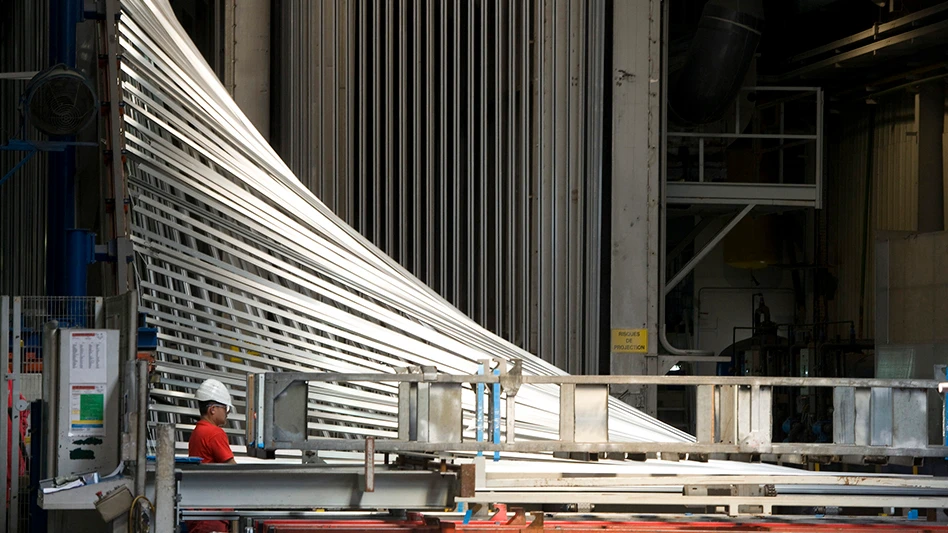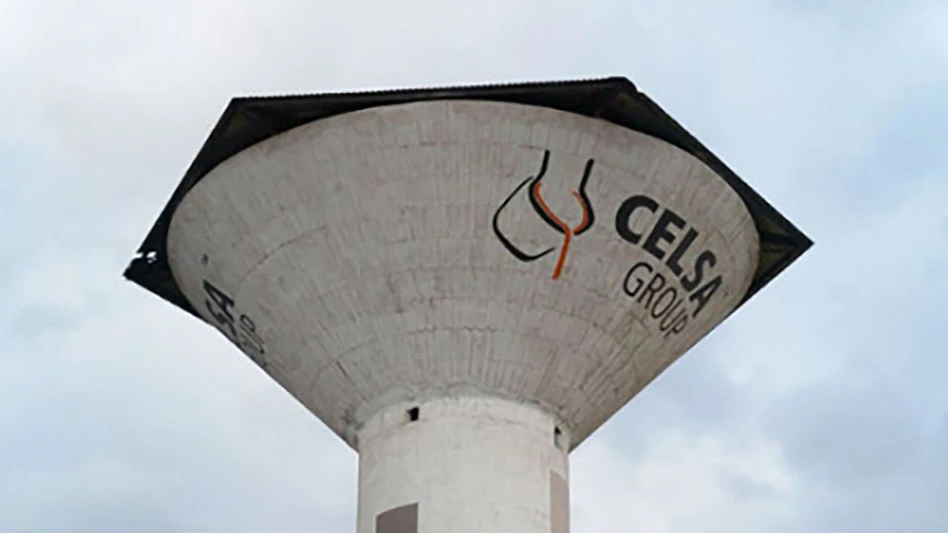
Photo courtesy of Hydro
Norsk Hydro ASA has reported its second-quarter financial results, which included adjusted earnings before interest, taxes, depreciation and amortization (EBITDA) of 5,839 Norwegian kroner million ($29.3 million), which was lower than the 7,098 million Norwegian kroner ($643.4 million) it reported for the second quarter of 2023.
The Oslo, Norway-based company attributes the year-over-year decline in adjusted EBITDA to lower extrusions volumes, recycling margins and energy spot sales and higher fixed costs.
"The positive development in our key revenue drivers from the first quarter continued into the second quarter, supporting solid results in our upstream businesses,” Hydro CEO Eivind Kallevik says in comments accompanying the company’s quarterly results. “We are mitigating the challenges of a weak downstream market by executing cost-saving measures and maintaining extrusion margins.”
Economic growth forecasts stabilized at relatively low levels during the second quarter, while economic uncertainty continued to decrease with headline and core inflation trending downward and external sources estimating real gross domestic product growth of around 2.7 percent in 2024, the company says.
Global primary aluminum demand was up 2 percent year on year during the second quarter, driven by a 3 percent increase in China, supporting overall growth in global primary demand of 3 percent year on year for 2024. Key uncertainties going forward are inflation stickiness, policy support, Chinese economic growth, the conflicts in Ukraine and the Middle East and the geopolitical situation.
Hydro says positive revenue drivers continued into the second quarter, supporting solid results in its Bauxite & Alumina and Aluminum Metal business units. The Platts Alumina Index (PAX) started the quarter at $367 per metric ton, gradually increasing to $505 per metric ton by quarter-end, driven by alumina production curtailments and disruptions in Australia and India, bringing the World ex-China market into balance. The three-month aluminum price ended the quarter at $2,524 per metric ton.
“Positive revenue drivers combined with ongoing improvement initiatives, including the ongoing fuel switch at Hydro Alunorte, are expected to further strengthen value creation from upstream activities going forward,” Kallevik says.
Downstream, demand in the residential building and construction segments in Europe and North America remains weak but is expected to improve with lower interest rates and a positive industrial outlook. Low activity in these markets continues to challenge aluminum scrap availability and pressures recycling margins, Hydro says, with several recyclers running on reduced capacity, affecting Hydro Extrusions and Metal Markets.
Automotive extrusion demand in the second quarter was challenged by lower electrical vehicle sales growth and weak trailer build rates in the transportation segment, the company adds, noting that London-based CRU Group has revised its extrusion demand forecasts lower for the second half of 2024, expecting a slower recovery.
Hydro Extrusions has responded with mitigating measures, according to the company. It is using its production flexibility and adaptation abilities to maneuver weak demand, while cost-cutting programs and manning reductions are helping to uphold margins. Managing short-term volatility enables Extrusions to continue positioning for long-term growth with customers, and two new original equipment manufacturer contracts were added to the portfolio during the second quarter to bring the company’s contracted total to 3.1 billion to 3.3 billion euros ($3.4 billion to $3.6 billion) since the beginning of 2023. The company adds that its Extrusions business is positioned to deliver on the 2025 EBITDA target of 8 billion Norwegian kroner ($73 million) when markets recover, though recent extrusion demand forecasts indicate a delayed realization.
The company’s recycling margins were pressured by weak markets, which underscores the need to diversify its portfolio and strengthen margins and scrap sourcing, Hydro says.
During the second quarter, Hydro decided to invest $85 million in a new casting line at its recycling facility in Henderson, Kentucky, to supply the U.S. automotive market with high-quality recycled automotive components. The project introduces HyForge technology to the U.S., serving the automotive market’s need for high-quality forge stock and broadening Hydro’s product portfolio. Further, the Alusort joint venture with metals recycling company Padnos in Michigan completed its HySort installation, enabling the U.S. plants to sort and use more postconsumer scrap.
Demand for Hydro’s low-carbon and recycled aluminum, Hydro Circal, has remained strong despite weak markets, according to the company. Recyclers, Luce in France and Atessa in Italy, are upgrading to meet rising European demand, and the bicycle company, Brompton, introduced wheel rims made from 100 percent post-consumer aluminum scrap during the quarter. Beyond Europe, greener products are gaining traction in the U.S., and the first sale of Hydro Circal was made during the second quarter. These efforts are estimated to strengthen Hydro’s recycling margins and resilience and align with the 2030 recycling targets, the company adds.
“Demand growth for low-carbon products remains strong with Hydro Circal sales well above target for 2024," Kallevik says. "This gives confidence to continue to push forward on strengthening our portfolio to capture long-term positions in the rapidly growing market for low-carbon products.”
Delivering low-carbon products creates value for Hydro’s customers at premium pricing. Leveraging the integrated value chain with traceability from mine to component, Hydro is attracting strategic partnerships with industry leaders that include the German sports car manufacturer Porsche AG. The agreement signed in Stuttgart on July 9 enables Hydro to deliver best-in-class, low-carbon aluminum for Porsche’s vehicle production in the future, and the scope of the agreement includes Hydro Reduxa and Hydro Circal products. Hydro is well-positioned to capitalize on greener premiums, with the potential for 2 billion Norwegian kroner ($181 million) in earnings uplift by 2030.
“The agreement with Porsche is [the] first of its kind in the aluminum industry and represents a totally new business model proving the underlying value of Hydro’s efforts throughout our value chain to pioneer the green aluminum transition,” Kallevik says.
The company adds that securing access to renewable power is crucial for growth in low-carbon aluminum. Therefore, Hydro and Macquarie Asset Management launched their renewable energy partnership June 24, establishing Hydro Rein as a joint venture where Hydro owns 50.1 percent and Macquarie 49.9 percent of the company. With the capital provided by Macquarie, Hydro Rein is expected to be fully funded for its current projects under construction and for development costs associated with projects in the pipeline in the coming years.
“With Hydro and Macquarie Asset Management’s complementary capabilities on the ownership side, Hydro Rein is well-equipped to continue pursuing profitable growth, supporting industrial decarbonization through growing in the Nordics, selected European markets as well as in Brazil,” Kallevik says.
Results and market development per business area
Adjusted EBITDA for Bauxite & Alumina increased compared with the second quarter of last year, from 817 million Norwegian kroner ($74.0 million) to 1,616 million ($146.5 million), which mainly was driven by higher alumina sales prices, lower cost of raw materials, and increased sales volume, partly offset by increased alumina sourcing costs and increased other fixed and variable costs.
Adjusted EBITDA for Energy decreased in the second quarter from 854 million Norwegian kroner ($77.4 million) to 611 million Norwegian kroner ($55.4 million) compared with the same period last year. Lower production, prices and gain on price area differences was partly offset by the expiration of a 12-month internal fixed-price-purchase contract from Aluminum Metal with a significant loss in the same period last year. Average Nordic power prices in the second quarter of 2024 ended below the prices from the previous quarter and the same quarter last year.
Adjusted EBITDA for Aluminum Metal decreased in the second quarter 2024 compared with the second quarter of 2023 from 3,215 million Norwegian kroner ($291.4 million) to 2,520 million Norwegian kroner ($228.4 million) mainly because of reduced contribution from power sales, increased alumina and energy cost and inflation on fixed cost, partly offset by reduced carbon cost. Global primary aluminum consumption was up 2 percent compared with the second quarter of 2023, driven by a 3 percent increase in China. The three-month aluminum price increased throughout the second quarter from $2,337 per metric ton to $2,524.
Adjusted EBITDA for Metal Markets decreased in the second quarter of 2024 year over year from 334 million Norwegian kroner ($30.3 million) to 309 million Norwegian kroner ($28 million) because of lower results from recyclers and negative currency effects, largely offset by strong results from sourcing and trading activities. Lower results from recyclers are the result of reduced sales prices in a weakening market and additional margin pressure in a tightening scrap market, while Alumetal contributed positively after its acquisition in the third quarter of 2023.
Adjusted EBITDA for the company’s Extrusions business decreased year over year in the second quarter of 2024 from 2,013 million Norwegian kroner ($182.4 million) to 1,377 million Norwegian kroner ($124.8 million), mainly driven by lower extrusion sales volumes and decreased margins from recyclers. General inflation pressured fixed and variable costs, partly offset by cost measures, Hydro says. European extrusion demand is estimated to have decreased by 14 percent year over year in the second quarter of 2024 but increased by 5 percent compared with the first quarter of this year, which was partly driven by seasonality.
Automotive extrusion demand has been challenged by lower growth in electric vehicle sales, Hydro says, while demand from the residential building and construction and industrial segments have started to stabilize at relatively weak levels. Extrusion demand has been relatively better in Southern Europe, while demand in Germany continues to be weak. North American extrusion demand is estimated to have decreased 5 percent during the second quarter of 2024 year over year and to increase 1 percent compared with the first quarter of this year. The transport segment has been particularly weak, driven by lower trailer build rates.
Latest from Recycling Today
- Greenwave Technology pares back losses in Q3
- Lindner shredders prepare Brazilian plastic for recycling
- China ups steel output while other nations cut back
- ReElement, Posco partner to develop rare earth, magnet supply chain
- Comau to take part in EU’s Reinforce project
- Sustainable packaging: How do we get there?
- ReMA accepts Lifetime Achievement nominations
- ExxonMobil will add to chemical recycling capacity





